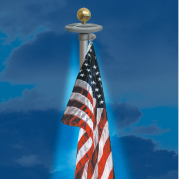The 50-Star American Flag
The story of the fifty-star flag is an intriguing tidbit of American history. It begins with the impending statehood of Alaska and Hawaii. Between 1898-1912 Alaska and Hawaii both became United States territories. In 1916 the first official statehood bill for Alaska came before Congress, and three years later the bill for Hawaii followed. Statehood legislation was brought up year after year for both territories, but by 1958 it seemed only Alaska would gain statehood.
Flag makers began designing forty-nine star flags anticipating the addition of a new state. Meanwhile, seventeen-year-old Bob Heft decided to create a fifty-star flag for his high school history project. Wise beyond his years, Heft already had an ongoing interest in flags and politics. He concluded that Pres. Eisenhower, who was a Republican, would want to add Hawaii shortly after the addition of Alaska, since Hawaii was predominantly Republican and Alaska Democratic.
Heft used his mother's sewing machine and a hot iron to add a new blue canton and 100 hand-cut stars (50 for each side) to the field of an old forty-eight star flag. With a yardstick he was able to place the stars in a proportional pattern. After 12 grueling hours, his flag was sewn and pressed. Heft handed the project in to his history teacher, Stanly Pratt. Pratt first asked Heft where he got his crystal ball, referring to Heft's presumption that Alaska and Hawaii would both be added to the Union. He then commented that if the design was accepted by Congress, he'd change the grade from a B minus to an A. Heft was up for the challenge. He first sent his flag to Ohio's governor, and then gave it to Congressman Walter Henry Moeller. Heft asked Moeller to store the flag until there was a need for a fifty-star flag.
In January of 1959, Alaska was admitted into the Union. July 4 of that year, the forty-nine-star flag became official, but it was short lived. By the end of August, Eisenhower signed a proclamation adding Hawaii to the Union, as Heft had predicted. Congressman Moeller brought Heft's flag to the design committee, where Eisenhower himself selected the flag to become the national emblem. On July, 4 1960, Heft and Eisenhower stood together in Washington to watch the first fifty-star flag be raised.
Since then Heft's flag has been all over the world, flying over American embassies, state capitol buildings and the White House. Turning down a $500,000 offer from a museum, Heft decided to keep his flag, no longer putting it on display.
In 2003 The Ohio Historical Society placed a Historical Marker in front of Heft's high school. The marker says:
"The design for the fifty star flag was born here at Lancaster High School in 1958 when student Robert Heft designed it for a history class project... Heft constructed a fifty star flag from an old 48-star flag using blue cloth to replace the field and white adhesive for the stars... President Dwight D. Eisenhower made the design the official American flag in 1960. It is the only flag in American history to have flown over the White House for more than five administrations."
On July 4, 2007, the fifty-star flag will become America's longest serving flag.
References Flag: An American Biography by Marc Leepson 2004. "The Fifty Star Flag: A Symbol of America" The Ohio Historical Society 2003.



















